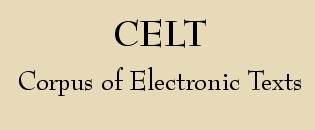|
Methodology and practice
This document explains how the online texts in HTML for use
with a plain Web browser are generated from the TEI master copies.
Representation of the markup
HTML does not possess sufficient capability to represent
adequately all the various nuances of markup which are encoded
in the original copies. It is therefore necessary to make some
typographical judgments about how best to retain as much of the
original value as possible, without overloading the display.
To see the original TEI file, with all the markup preserved,
you can use a real SGML browser like Panorama or
MultiDoc Pro for
which stylesheets and resource files
have been developed. In the meantime, the following
representations have been adopted:
- Abbreviations (<abbr>)
- Italics
- Additions (short) (<add>)
- Italics
- Additions (long) (<addspan>)
- The Section symbol in curly braces {§} marks the
start of a longer addition (one spanning across other
markup). The endpoint of the addition is
marked by another Section symbol.
- Additional names (<an>)
- Unmarked, but names in general are in bold.
- Apparatus criticus
(<app>)
- Parallel readings are hyperlinked. Where a lemma is given,
this is highlighted, and clicking on it reveals the
readings. Where no lemma was given, the last reading is given
in the text, and a Section symbol (§) is highlighted,
providing access to the other readings.
- Corrections (<corr>)
- Italics
- Deletions (<del>)
Strikethrough- Expansions (<ex>)
- Italics
- Forenames (<fn>)
- Unmarked, but names in general are in bold
- Foreign (<frn>)
- Italics
- Gaps (<gap>)
- [Reasons italicised in brackets]
- Group names (<gn>)
- Unmarked, but names in general are in bold
- Scribal hands (<hand> and
<handshift>)
- If identified, the identity is in bold; the name of
the hand is enclosed in [brackets] followed by the name of the
scribe, if known.
- Highlighting (<hi>)
- has been used to highlight examples
of this encoding.
- Linebreaks (<LB>)
- Line numbers start the line followed by a single closing
bracket]
- Lemmata (<lem>)
- See Apparatus criticus
- Line groups (<lg>)
- Stanzas are numbered where appropriate. Lines within
stanzas are numbered only if encoded with exogenous numbering
- Milestones (<mls>)
- Foliation is given in {curly braces}
- Name links (<nk>)
- Particles are not separately highlighted
- Numbers (<num>)
- Numbers are not given any typographic distinction
- Organisation names (<on>)
- Bold
- Page breaks (<pb>)
- Horizontal line across the screen, page number in small
type on the right.
- Personal names (<ps>)
- Bold
- Placenames (<pn>)
- Bold
- Readings (<rdg>)
- See Apparatus criticus
- Regularisation (<reg>)
- Italics
- Role names (<rn>)
- Unmarked, but names in general are in bold
- Sic (<sic>)
- Underlined
- Surnames (<sn>)
- Unmarked, but names in general are in bold
- Supplied (<sup>)
- Italics
- Special terms (<term>)
- Bold
- Unclear (<uncl>)
- Text is enclosed in (parentheses).
Character representation
Length marks
The ISO 8859-1 (Latin-1) character set is used by default,
but this handles only one length mark, the fada or
acute, and only over vowels. When XML software becomes
available, UniCode (ISO 10646) will be used.
Editorial length marks given as macrons in the source texts
are shown in the HTML copies online as acute accents on vowels, but with
the character underlined. Macrons on non-vowels are shown by
underlining only. A rare suspension
dí (dī) is spelled out in
full as didiu.
Other diacritics
The séimhiú (dot-over) accent is
rendered with a following `h' and underlined. The dot-under
accent used to indicate elision is rendered with underlining alone.
The notum for uel, graphically identical with
stroked-l is rendered l^, L^.
E, e with an ogonek which represents tall e (e-caudata) are
rendered as simple E, e, but underlined.
The Insular Ampersand is rendered &.
If you have any suggestions about how the information
could be better presented in HTML, please let us know.
|

